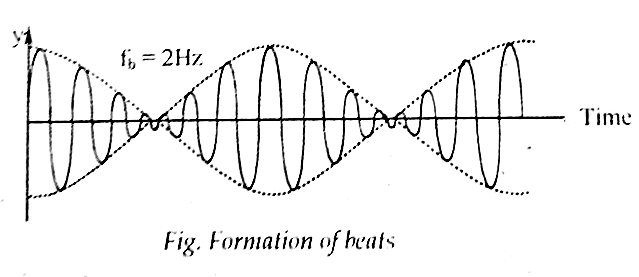How are beats formed when two waves are superimposed? Deduce expression for the frequency of beats so formed.
1 Answer
Beats: When two sound waves of slightly different frequencies are sounded together, there occurs a periodic rise and fall of sound intensity. Such a phenomenon is known as beats. The time between a rise and a fall is called a beat period. The number of beats heard per second is called beat frequency. It is given by \(f_{}=f_2-f_1\)
Now let us consider two waves of equal amplitude 'a' but of slight frequencies. Let the frequencies of the waves be f1 and f2 where f1 > f2.
Consider y1 and y2 are the individual displacements of the medium at a time t due to these waves, then
\(y_1=a\sin\left(\omega_1t\right)=a\sin\left(2\pi f_1t\right)\)
And, \(y_2=a\sin\left(\omega_2t\right)=a\sin\left(2\pi f_2t\right)\)
Applying the principle of superposition of waves, the resultant displacement of the vibrating particles is given by
\(y=y_1+y_2\)
Or, \(y=a\sin\left(2\pi f_1\right)+\sin\left(2\pi f_2\right)\)
Or, \(y=2a\sin\left(2\pi\left(\frac{f_1+f_2}2\right)t\right)\cos\left(2\pi\left(\frac{f_1-f_2}2\right)t\right)\) \(\left[\because\sin\left(A\right)+\sin\left(B\right)=2\sin\left(\frac{A+B}2\right)\cdot\cos\left(\frac{A-B}2\right)\right]\)
Or, \(y=A\sin\left(2\pi ft\right)\) -------- (i)
Where, \(A=2a\cos\left(2\pi\left(\frac{f_1-f_2}2\right)t\right)\) is called the amplitude of the resultant wave (the amplitude factor) and \(f=\left(\frac{f_1+f_2}2\right)\) is the resultant frequency.
So, equation (i) represents the equation of the harmonic wave whose frequency is f and the amplitude is A which varies with time.
Condition for maxima and the minima:
Condition for maxima:
A beat (loud sound) is detected when the amplitude is maximum. Amplitude 'A' will be maximum when \(\cos\left(2\pi\left(\frac{f_1-f_2}2\right)t\right)\) is maximum.
i.e., \(\cos\left(2\pi\left(\frac{f_1-f_2}2\right)t\right)=\pm1\)
Or, \(\cos\left(2\pi\left(\frac{f_1-f_2}2\right)t\right)=\cos\left(n\pi\right)\)
Or, \(2\pi\left(\frac{f_1-f_2}2\right)t=n\pi\)
Or, \(t=\frac n{f_1-f_2}\)
When, n = 0, 1, 2, 3,..... The time interval between two consecutive maxima is the period and is given by \(T=\frac1{f_1-f_2}\)
Hence frequency of maxima is \(f=\frac1T=f_1-f_2\)
Condition for minima:
Resultant amplitude is minimum when \(\cos\left(2\pi\left(\frac{f_1-f_2}2\right)t\right)\) is minimum.
i.e., \(\cos\left(2\pi\left(\frac{f_1-f_2}2\right)t\right)=0\)
Or, \(\cos\left(2\pi\left(\frac{f_1-f_2}2\right)t\right)=\cos\left(\left(2n+1\right)\frac\pi2\right)\)
Or, \(t=\frac{2n+1}{2\left(f_1-f_2\right)}\)
So, when n = 0, 1, 2, 3,...
\(t=\frac1{2\left(f_1-f_2\right)},\frac3{2\left(f_1-f_2\right)},\frac5{2\left(f_1-f_2\right)}\)
The time interval between two consecutive minima i.e., beat period is given as
\(T=\frac3{2\left(f_1-f_2\right)}-\frac1{2\left(f_1-f_2\right)}\)
Hence frequency of minima is \(f=\frac1T=f_1-f_2\)
And the frequency of maxima is \(\left(f_1-f_2\right)\) = frequency of minima = beat frequency = f. Thus, beat frequency is equal to the difference of the frequencies of individual superposing waves.


